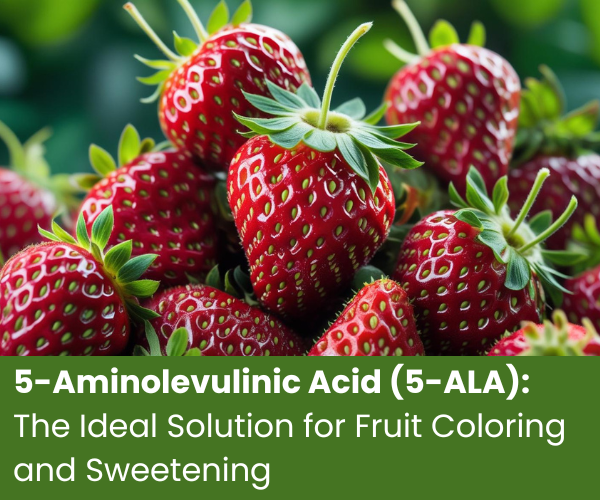5-Aminolevulinic Acid (5-ALA) is an important natural organic compound and an essential precursor in the biosynthesis of chlorophyll, heme, vitamin B12, and other critical substances in plants, animals, and microorganisms. In agricultural production, 5-ALA has been widely researched and applied to improve fruit quality, enhance stress tolerance, and regulate growth, making it a key technology supporting sustainable agriculture.
Mechanism of Action in Agriculture
Modern studies have demonstrated that 5-ALA has multiple physiological regulatory functions in crops:
- Promotes chlorophyll synthesis
Increases chlorophyll content, enhances photosynthetic capacity, and accelerates biomass accumulation. - Improves photosynthetic efficiency
Strengthens light energy conversion and utilization in plants. - Enhances stress tolerance
Improves resistance to salinity, drought, low temperature, and other adverse conditions. - Stimulates anthocyanin and flavonoid accumulation
Significantly increases the synthesis of pigment compounds in fruit skins. - Improves nutritional quality
Boosts soluble solids content and sugar-acid ratio, enhancing sweetness and flavor.
Why Does 5-ALA Significantly Promote Fruit Coloring and Sweetening?
During the later stages of fruit development, 5-ALA regulates the expression of genes related to anthocyanin biosynthesis, accelerating the accumulation of pigments. This results in more uniform and vibrant fruit coloration.
Moreover, 5-ALA facilitates the accumulation of sugars in fruits, increasing soluble solids content and improving taste and marketability.
Compared to traditional ripening agents such as auxins or ethephon, 5-ALA offers several advantages:
- No excessive ripening or shortened shelf life
- Remarkable coloring and sweetening effects
- Low risk of phytotoxicity or harmful residues
- Safer and more environmentally friendly
These benefits have made 5-ALA increasingly popular among growers seeking to maximize fruit quality and value.
Recommended Concentrations and Applications
The effects of 5-ALA depend closely on the concentration used. Different concentrations serve distinct purposes:
High Concentration (>838 mg/L)
- Applications: As a biological insecticide, fungicide, or herbicide
- Note: Primarily used in specialized research or professional applications
Medium Concentration (100–300 mg/L)
- Applications: Thinning flowers and fruits, stimulating early fruit development, accelerating coloration prior to harvest
- Timing: Sprayed during the fruit ripening stage
Low Concentration (≤100 mg/L, especially ≤10 mg/L)
- Applications:
- Promoting seed germination
- Enhancing root and shoot growth
- Improving stress tolerance
- Increasing yield and crop quality
Before application, concentrations and frequency should be determined based on the crop type, growth stage, and specific objectives.
Product Specifications and Application Guidelines
We supply high-purity 5-ALA fermentation liquid with a concentration of 40g/kg, suitable for diverse crops and formulation needs. Application rates can be flexibly adjusted to achieve the desired concentration:
- Foliar spraying: Dilute as needed (e.g., approximately 300 times) and apply evenly.
- Soil drenching: Approx. 1 kg per acre; adjust according to crop stage.
- Liquid water-soluble fertilizer: Recommended 30–40 L per ton of finished product.
- Foliar fertilizer preparation: Recommended 80–100 L per ton.
Usage Notes:
- Avoid mixing with alkaline substances to prevent loss of efficacy.
- When used together with other plant growth regulators or stimulants, reduce dosage appropriately.
- If using water as a carrier, adopt suitable preservation measures to avoid contamination or degradation.
Proven Field Results
Field trials have shown that properly applied 5-ALA can significantly improve performance in apples, grapes, tomatoes, blueberries, and other crops:
- Anthocyanin content increased by 20–40%
- More uniform and vibrant skin coloration
- Soluble solids content increased by 1–2%
- Enhanced sweetness and flavor
- Improved stress resistance and shelf life
These effects help growers produce premium fruits with higher added value and stronger market competitiveness.
With the growing focus on sustainable and high-quality agricultural production, 5-ALA has become an essential tool for fruit coloring and quality improvement. When applied scientifically and responsibly, it can help growers significantly enhance both the appearance and nutritional value of their crops, while reducing reliance on conventional ripening chemicals.
If you would like to learn more about our 5-ALA solutions or receive customized technical support, please feel free to contact us. Our team is ready to provide professional assistance and recommendations.


